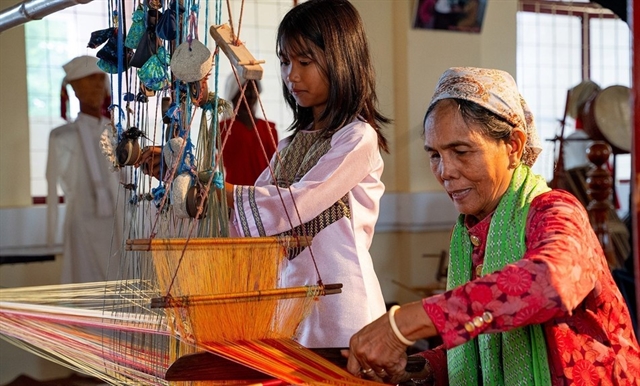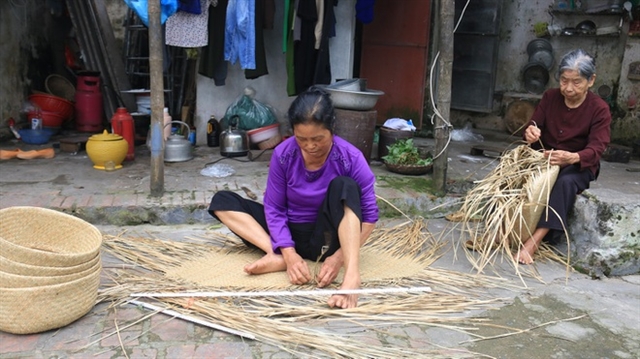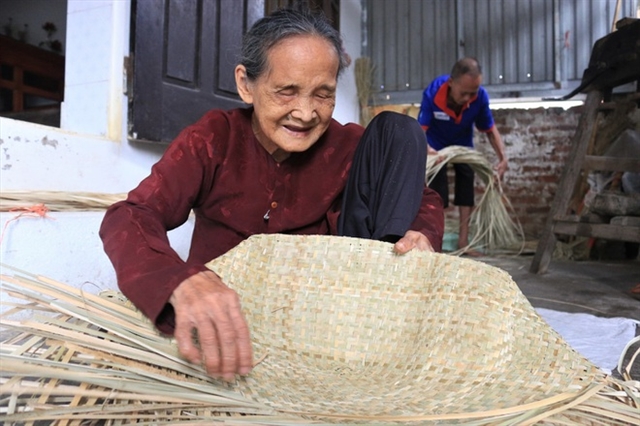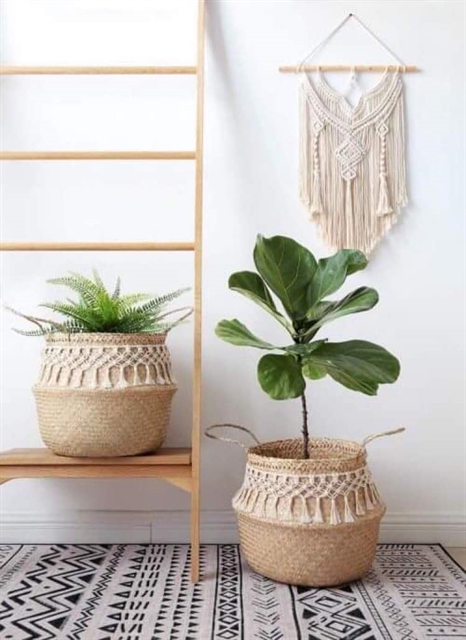 Features
Features

Sedge bags made in Tống Vũ Village in the northern province of Thái Bình have been favoured among Vietnamese with a green lifestyle in recent years.

|
| The elderly are the main makers of sedge bags in Tống Vũ Village. Photo dantri.com.vn |
By Hà Hiền
Sedge bags made in Tống Vũ Village in the northern province of Thái Bình have been much favoured among Vietnamese with a green lifestyle in recent years.
These environmentally-friendly products are meticulously woven, largely by senior villagers who are around 70 years old.
In the past, about 90 per cent of households in the village used to practise the craft. However, like other traditional craft villages, Tống Vũ has been severely affected by rapid urbanisation.
Most of the young locals have left the village to seek jobs in big cities or industrial zones, so only a few dozen villagers still engage with the craft, mostly the elderly.

|
| 83-year-old Phạm Thị Việc still weaves sedge bags despite her poor eyesight. Photo dantri.com.vn |
Phạm Thị Việc, 83, is a tireless artisan of the village. Despite her poor eyesight and hunched back, she weaves the bags at home in the morning and in her neighbour’s house in the afternoon, where she has a chat with other residents.
“Other than sick days, I make from four to five bags a day,” she says.
The process of making a complete product consists of many stages such as soaking, drying, splitting the sedge threads, pressing, weaving, twisting the handles and refining.
According to Việc, the work is not difficult but requires ingenuity and tasks are divided by gender. While the women are responsible for the weaving, the men help with the splitting, pressing threads and making handles.
However, sitting continuously for several hours causes back pain, joint fatigue and blurred vision. It’s also tough work.

|
| While the women are responsible for the weaving, the men help with the splitting, pressing threads and making handles. Photo dantri.com.vn |
Recalling the village of 50 years ago, villager Phạm Đình Ưu says: “Whole families used to gather to concentrate on making the sedge bags to earn extra money to buy food after the fields had been harvested.”
“Three generations of my family have been practising the craft. My parents, my wife, I, and my six children – all of us are proficient in weaving sedge bags. Now only two of us are still doing it, weaving about four bags a day, each of which is sold at barely VNĐ6,000.
“Fortunately, my children and grandchildren have gone to work in companies with stable and sufficient income, or it would be hard for us to make ends meet.”
Production today is less difficult than in the past as the villagers no longer have to travel tens of kilometres to buy the material. The sedge is now sold right in the village and can be sent straight to the doors of the villagers with a simple phone call.
Each 100 kilograms of sedge is sold at VNĐ800.000 (US$35) and used to weave about 1,000 bags.
In addition to traditional products for daily use, some younger villagers have modernised the bags for export to earn them higher income, such as Vũ Thị Nhau who is a decade younger than Việc.
These types of exported bags require higher skills and extreme precision is needed in getting the correct length and width, while the handle must remain thin but strong.
“I work for a local export company that provides me with a machine and material. I just need to weave the product according to the pattern that they request. Making four bags can earn me about VNĐ136,000 per day, which is sufficient to cover my daily costs such as medicine and food,” Nhau says.

|
| Tống Vũ villagers have created more diverse products from sedge such as decorative plant pots. Photo Phạm Long Facebook |
Following the trend in sustainable lifestyles, with people preferring handicraft products made from natural and environmentally-friendly material, the villagers have created more diverse products from the sedge such as decorative items and cushions both for domestic demand and export.
The products of the village have also had access to a wider group of consumers from across the country, with the local youths promoting them on various Facebook pages.
"People can use sedge bags for shopping to eliminate the use of plastic bags. Each sedge bag has a lifespan of one to two years, depending on its use,” says 21-year-old villager Phạm Xuân Long.

|
| Phạm Xuân Long has introduced the environmentally-friendly products of his hometown on his personal Facebook page. Photo Phạm Long Facebook |
“If they are damaged and become unusable, they can be composted into organic fertilizer.”
After four months of marketing the products of the village on his Facebook page, Long has received much support and many orders from green customers in localities such as Đà Nẵng or HCM City.
The young generation has provided a bridge to connect Tống Vũ’s traditional products to new markets while reviving a craft that otherwise would be at risk of falling into oblivion. VNS




